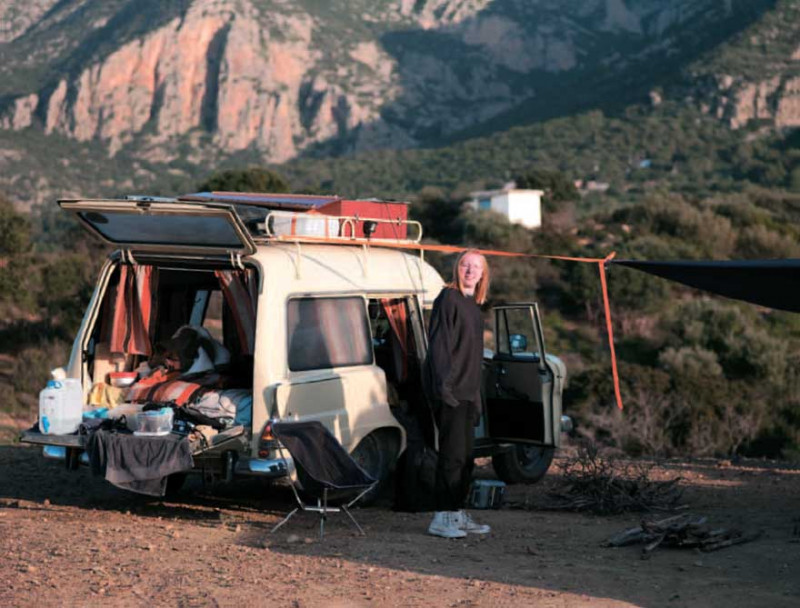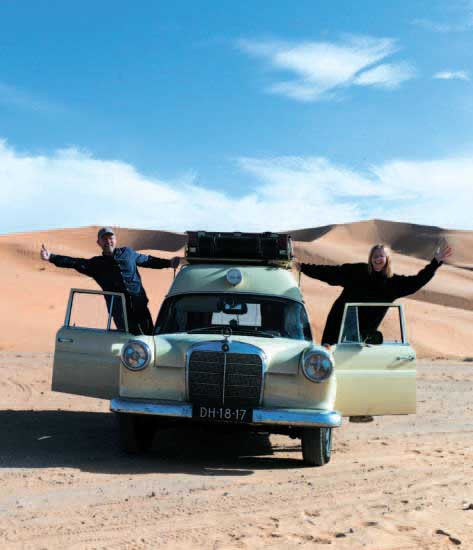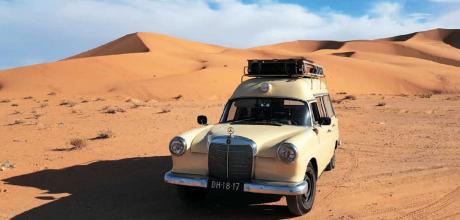1965 Mercedes-Benz 190Dc Ambulance W110
Blessed with a restored W110 190Dc ambulance and motivated to escape the stresses of everyday life, the father and daughter team of Loek and Nika Scheepers began the road trip of a lifetime.
WORDS ROBB PRITCHARD
IMAGES LOEK & NIKA SCHEEPERS
Benz odyssey
“We kept our fingers crossed, but that’s all part of the joy about travelling in a car such as this Mercedes

This amazing journey began with a sad event. Following his mother’s passing, Loek Scheepers decided to do something a bit special with the inheritance she left, and with his teenage daughter Nika planned a once in a lifetime road trip from the Netherlands to Iran via North Africa. For such a mammoth expedition, most of us would want the most reliable camper, maybe even armoured, but Loek chose to do it a rather different way and dragged his 1965 W110 190Dc ambulance out of storage, where it had sat for 27 years.

Loek thinks Mercedes ambulances are the most efficient way of going camping. Over the years, he’s found the running costs lower and parking easier than when at the wheel of a full sized camper. His favourite is the W123, but he wanted the challenge and special experience of a road trip in a much older W110 with body adapted by Miesen.
“As the weeks back in the Netherlands turned into months, the hope that Lieske was still there untouched began to fade”
Left untouched for nearly 30 years, the main issue was understandably corrosion, and with a full strip down the doors, sills and floor all needed replacing. Rear doors for 65-year old ambulances are hard to come by, so Loek modified a set of later ones to fit. The 1.9-litre diesel engine hadn’t turned over for at least 20 years, but with a new battery and an oil change it ran much smoother than expected. With a new starter motor, water pump and alternator, the ambulance was christened ‘Lieske’ after Loek’s mother, and after a year of preparation, including adding mattresses and sleeping bags in the back, Loek and Nika were ready to go. That was in January 2020, and they thought that 2020 would be a good year to travel…
At first, the engine’s oil pressure was really high, but as an old school mechanic used to getting simple components to work, Loek wasn’t too concerned and simply attached a pipe from the overflowing dipstick tube back into the block. “But even then, the pressure was still a bit high, so I fed the overflow pipe into a flask that I zip-tied into the engine bay, and drove along while keeping an eye on the gauge, and poured it back into the engine when the needle got a bit low,” Loek explains. After about 180 miles through France, the piston rings freed up enough that all was fi ne. The 65-year old clutch and 25-year old head gasket also worked as they should. “We kept our fingers crossed,” Loek remembers. “But that’s all part of the joy about travelling in a car such as this Mercedes.”
They drove between 150 and 200 miles a day, constantly annoying other road users with their snail’s pace, especially on hills which the 54bhp Benz struggled on. After a couple of weeks of leisurely cruising along the back roads of Europe, they arrived in Almeria in Spain for the ferry to Algiers. “It was so funny as there were many friendly but concerned Algerians trying to convince us that we were on the wrong ferry, as no one would ever be crazy enough to drive a classic car to Algeria.”
Despite all the pre-arranged paperwork, they weren’t quite ready for the nightmare of getting through Algerian customs. The guards spent a while sifting through all the documents Loek and Nika had spent weeks getting sorted, such as invitations from people from Couchsurfing (a free hosting website for travellers), letters from work, bank accounts and insurance. But trying – and failing – to get Loek to commit to a strict itinerary rather than wandering around where he wanted, the guards really didn’t know what to do. “In the end, I think they just gave up and wanted to get rid of us. 50 metres after the customs, we were waved into the police and had to do the whole process all over again,” Loek says. “At least these guys there were friendly though and were just as interested in getting selfies as they were checking our papers. And then we were in Algeria!”
From the port city of Oran, their spirit of adventure led them south into the vast and desolate wastelands of the Sahara desert, through exotic sounding places such as Tlemcen and Taghit. One of the first lessons was in dealing with the big and unmarked speed bumps scattered randomly over the road. Another was about the raw, open friendliness of the locals. “People were honking at us as they drove by and everyone wanted to talk and ask us loads of questions,” Loek recalls.
From Taghit they decided to take the remote desert road to Bnoud, but the locals gave them dire warnings against it. It is 200 miles of nothing but desert, out of cell phone coverage and the last 20 miles was unpaved so some heavy off-roading was expected. “We’re Dutch and stupid,” Loek smiles. “They said we couldn’t do it, so we had to. And to be all alone in the Sahara with the colours of the desert changing all the time, and the wild camels – it was amazing.”
Until, that was, the ancient head gasket burst. “As I heard the note of the engine change and saw the smoke, my heart sunk.” There is never a great place to blow up an engine, but if you had to choose, perhaps the fringes of the Sahara desert on a road even the locals don’t dare to drive, would not be the first choice. They managed to coax Lieske another 90 miles to their host’s house in Tissemsilt, but once there the engine seized.
While this could have easily been the worst experience of the trip, or even the end of the trip, it actually turned into one of the nicest. “Seeing Lieske on the back of a recovery truck, where she got scratched and dented, and then watching her get disembowelled in an African garage, I had a bit of a cry,” Loek admits. “And then we found out that there was no suitable gasket in the whole of the country, which wasn’t that much of a surprise.” Not even a story in the local Tissimsilt newspaper could help.
However, a Couchsurfing host on the other side of the country, with intimate knowledge of the workings of old Mercedes engines, said that a gasket from a later OM615 engine would fit the ambulance’s OM621. All they had to do was make sure that the 615’s gasket didn’t blank off holes in the block.
“But he didn’t just put it in the post,” Loek laughs. “Cherif put it in a taxi and sent it to us. A 220-mile trip!” And Khadi, the mechanic who’d spent hours under the bonnet, was equally gracious. “When he had finished, he said that he was my friend and that I should go in peace and not pay him anything. It was a truly heart-warming experience.”
In a worrying cloud of black smoke, Lieske started up and everything otherwise seemed fine. Loek was confident enough to head deep into the desert to relax and, after a day exploring prehistoric sites, oases and remarkably preserved Roman ruins, he and Nika put their mattresses on the roof and slept under the stars.
And then they got to Cherif. He’d already sent the gasket by taxi, but now he was their host and spent a couple of days showing them his bees, a beautiful spring and the stunning ruins of Tipaza, a Roman settlement right on the azure coast of the Mediterranean. “I never imagined it before I went, but Algeria is the most beautiful country and every day we were amazed by the sights we saw, but mostly by the people we met,” Loek recalls. But with strict visas that couldn’t be extended, they needed to hurry up and get to Tunisia, where they planned to get the ferry back to Italy. Thankfully, the Algerian police helped them speed up a little. Tourists are few and far between in that part of the world and the police seem to think that every local is a potential kidnapper or terrorist, and that tourists should be kept safely away from them at all costs. They got across the border into Tunisia with a lot less issues than getting into Algeria. The initial itinerary had been to shoot across Italy, take another ferry to Greece, where Nika planned to volunteer in a refugee camp for a couple of weeks, then potter across Turkey, getting visas for Iran on the way, and eventually head back through the Balkans. But all of those plans unfortunately came to nothing.
It seems a long time ago now, but Italy was the first country in Europe to go into a full Covid lockdown and all ferries were cancelled with no notice. Like the rest of us, Loek couldn’t have known then what was going to happen, and the idea of camping in the desert until the panic blew over soon turned out to be wishful thinking. With the army on the streets of Tunis enforcing curfews, all tourists were given strict orders to leave – the only problem being that the car was stamped on their passports so they couldn’t cross the border without it. But then they got a call from the Dutch embassy instructing them to go immediately to the airport to get the last flight. They had no option but to leave Lieske in the airport car park, completely unattended.
As the weeks back in the Netherlands turned into months, the hope that Lieske was still there untouched began to fade. The only hope was that she was so old that no one would bother doing anything with her. It wasn’t until July that Loek and Nika managed to get a flight back to Tunisia, and with a sinking feeling went out into the car park. Somehow, Lieske was still parked where they’d left her. Someone had tried to break in but hadn’t tried too hard given several different things in your average toolkit would get the door open without too much trouble. After reconnecting the battery, Lieske started straight up and with the ferries running again she was soon back in Europe.
In Italy, the official rule was that they only had 37 hours to go from Civitavecchia to the northern border, which was quite a challenge in such a slow car, but the customs guards laughed and told them not to worry and to have a nice holiday. It wasn’t the same as Algeria, of course, but they still had Lieske and she took them on a sedate little holiday through Rome, Pisa, Florence, Bologna and Venice then over the Alps to Austria. There was an obligatory stop at the Mercedes-Benz Museum in Stuttgart before getting home. And Lieske will be ready for Iran once Loek has saved up enough money and the borders are all open again.
Just the facts 1965 Mercedes-Benz 190Dc ambulance (W110)
- ENGINE OM621 1,988cc 4-cyl
- MAX POWER 54bhp @ 4,200rpm
- MAX TORQUE 87lb ft @ 2,400rpm
- TRANSMISSION 4-speed manual, RWD
- WEIGHT 2,000kg
- YEARS PRODUCED 1961-1965
All figures from Mercedes-Benz
The road to Bnoud was tricky to say the least. Just one of many friends made by Loek and Nika.
The 190Dc was left at Tunis airport as lockdown came.
Home from home – the ambulance came into its own. Fold-out cooking station with gas hob came in handy.
The Mercedes became something of a celebrity. New head gasket sourced from the other side of Algeria.
Khadi the mechanic fixed the head gasket issue. A seized engine occured on the Sahara’s edge.
Nika at the wheel; note the vertical speedo.
“They drove between 150 and 200 miles a day, constantly annoying other road users with their snail’s pace”


